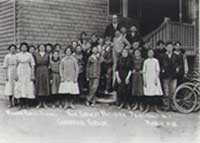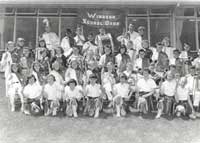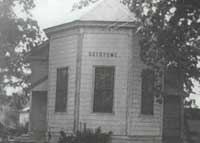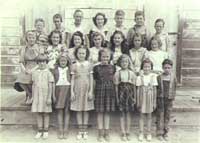ABOUT OUR DISTRICT
ABOUT US
LEGAL DOCUMENTS & REQUIREMENTS
STAFF & CAREERS
STUDENTS & FAMILIES
STUDENTS
PARENTS
EDUCATIONAL SERVICES
Mental Health & Wellness
Windsor Childcare Options
TRANSPORTATION SERVICES

SCHOOL BUILT IN 1886 – MASONIC LODGE UPSTAIRS

WINDSOR PUBLIC SCHOOL – 1912 EARNEST WASHBURN, PRINCIPAL

CLASS OF ’48 – 8TH GRADE

WINDSOR SCHOOL BAND

SOTOYOME SCHOOL

STARR SCHOOL – 1940
The Russian River Township (Windsor) was first settled in the 1850’s during the height of the California Gold Rush. The first schoolhouse was built near Shiloh Cemetery and served the area from 1853-1863. Historical records identify this first schoolhouse as being made from logs harvested from the nearby forest. The community changed the name to Windsor in 1855. The school’s first head master was John Pruitt, and as was the custom, the school was soon named after him. Windsor was a farming town. The children harvested fruit in the summer, picking apples, prunes, hops, and pears, and cutting grapes.
The next school came in 1863, replacing the original log school at a cost to the community of $2000. There were 51 registered students. The teacher’s salary was $68 a month. The enterprising community maximized space and helped create income for the school by adding a second floor to house the newly- chartered Russian River Masonic Lodge 181.
Within the township, all children walked to school. As the community grew, so did the schools. They were Windsor, Hill, Starr, and Sotoyome Schools. Hill School was on Chalk Hill road and was completed in 1863 and built on land donated by Sarah Myer Rich. Robert Hill was the first head master. Fire destroyed the building in the late 1890’s, and it was rebuilt providing service to the community until 1937 when it joined the newly formed Windsor Union School District.
Starr School, located on the southern end of Starr Road, was built in 1880, and Sotoyome School on Eastside road was established in April 1872.
In 1908, a new Windsor School was built in front of the existing school for $10,000, and served 90 students. Local documents identify the school as one of the most modern rural schools in California. The school bell monument that is currently located at Windsor Creek School came from the original bell tower. The bell monument has now been incorporated into the school district’s logo.
In 1951, a new Windsor School replaced the 1908 facility, and served students kindergarten through eighth grade with a third wing of classrooms being added in 1960. Starr School joined Windsor Union School District on July 1, 1951, and Sotoyome School followed on July 1 1956.
The “new” Starr School (presently Cali Calmécac Charter School) was built and occupied in January 1968. It originally opened as a 5th and 6th grade campus with Kindergarten. It was later converted to a 7th and 8th grade middle school. In August 1993, Windsor Middle School moved to Conde Lane and occupied the Windsor School site (now Windsor Creek Elementary).
In 1986, the District opened a dual immersion program, later to be named Cali Calmécac Immersion School. The English/Spanish immersion school was moved to the Starr School site in 1991, eventually providing instruction to students grades K-8, and quickly developing into a model program throughout California for language acquisition. Acknowledged by Sonoma State University as a Jack London Award winner, Cali Calmécac became a charter school under the District umbrella in 1998 and remains one of the largest Charter schools in the State.
Brooks Elementary School opened in 1988 with Joe Taylor, a native “Windsor Boy” serving as its first principal. The community continued to grow and many new subdivisions were added around the school to form the newly incorporated community of Windsor township.
On May 8, 1991, the Windsor Union School District Board of Trustees received a petition from the Windsor residents requesting unification of the District to serve its students from kindergarten through 12th grade.
For decades, Windsor students received their secondary education from Healdsburg High School District in the town of Healdsburg. The Windsor community recognized the value of having local control, and accountability for providing a complete K12 education.
Community surveys were conducted showing strong support for the unification of the Windsor Schools into a K-12 District. The Sonoma County Committee on School Reorganization and the State Board of Education approved a ballot measure to unify the Windsor community schools in 1992.
In April 1992, Windsor voters overwhelmingly passed the ballot measure to unify the District. Windsor began the formal process of separating the secondary (9-12) students from Healdsburg High School District. It took eight months to complete the site selection and receive state approval to build the new Windsor High School.
In 1993, the community was growing rapidly and it opened its newest primary school: K-1 Mattie Washburn Elementary School. The school was named after the first woman school administrator in Windsor schools.
By1999, a new middle school was opened on Brooks Road; however, it also housed high school students until a high school was designed and completed. The construction of the new high school began in the summer of 1997, with occupancy scheduled for July 2000. The first high school class graduated in 1999 from the middle school site, never having had the opportunity to attend the permanent campus.
Over four years, Windsor High School students’ education took place in offices, makeshift classrooms, borrowed labs, and adopted campuses (District office warehouse, Luther Burbank Center for the Arts, and temporary trailers on the WMS site). Under the leadership of its first principal, Jeff Harding, the High School students were true pioneers in the tradition of the early Gold Rush community that originally formed the Windsor Township of the 1850’s.
Today, Windsor Schools have four California Distinguished Schools, two California Golden Bell Awards, and are considered to offer some of the best academic programs in Sonoma County. In 2006 the State of California awarded the District its prestigious Governor’s Award for Environmental and Economic Leadership Award for acknowledging the District and Town for its joint efforts in environmental improvements in the public sector.
Compiled from notes, oral history, and text. Windsor History and Happening. Contributing authors: Edna Honsa, Cheryl Scholar, Steve Herrington.